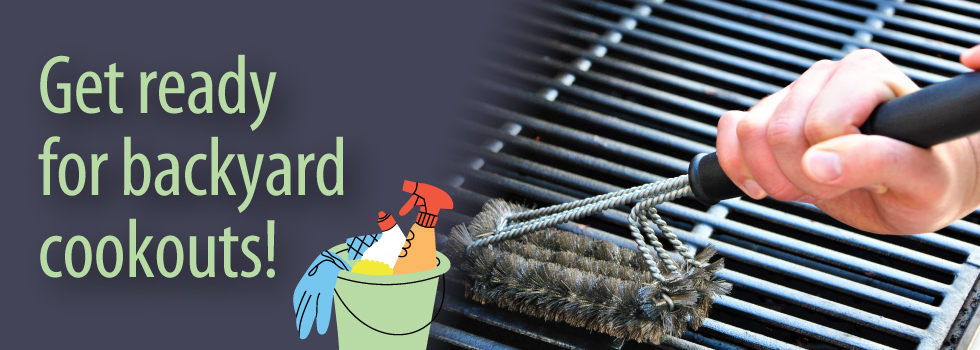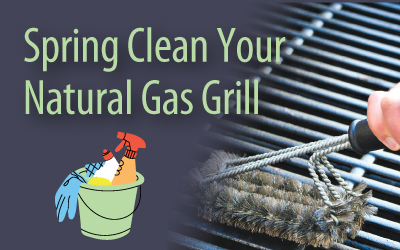
Do you have visions of grilling grandeur this summer? Don’t forget that the best steaks and burgers begin with a clean natural gas grill.
Now’s the time to get your equipment primed and
ready for another season of backyard cookouts.
Now’s the time to get your equipment primed and ready for another season of backyard cookouts. A thorough spring cleaning rids your grill of carbon deposits that can harbor bacteria, affect temperature regulation and cause premature failure of gas-burner tubes.
To give you a head start on culling the crud, we combed the internet in search of tutorials and hacks. There’s no legitimate solution that eliminates the need for some old-fashioned elbow grease and a chunk of time, but we did find some ideas for making the job easier.
The sizzle and smell of grilling food await. So, roll up your sleeves and get cleaning.
HOW-TO
Let YouTube show you how. If you learn better by watching someone else do something, head on over to YouTube to check out a video that demonstrates best practices for cleaning your grill. After viewing many (and there are a LOT) of these videos, we think the best tutorials are provided by Dave’s Ohio BBQ and Jared Waldron, the grilling social media sensation behind BBQ and Bottles. In about 12 minutes, each video gives a soup-to-nuts demonstration for deep cleaning a grill using common household items and homemade solutions.
Read step-by-step guidelines. If you prefer to read cleaning directions, there are plenty available. Among the most comprehensive we found are from:
- Family Handyman This eight-step guide doesn’t miss a thing. There are detailed suggestions, such as recommending the use of a flashlight or headlamp “to make sure you’re not missing anything” in the corner of the grill’s cookbox.
- Popular Mechanics offers a practical pig approach with hints like: “Avoid using chemicals to clean your grill, since they can impart an off taste to foods. Instead, all you need is some warm water, grease-cutting dish soap and a thick paste made of cleaning vinegar and baking soda.”
HACKS
There’s no shortage of “experts” promoting cleaning products and other “wonder” solutions meant to make cooked-on gunk magically disappear. Independent testers found ideas, such as soaking grates in hot coffee, to be mostly ineffective, costly (seriously, coffee is not cheap) and messy. So, save your money and instead employ these tried-and-true methods from some reliable sources.
- Take photos. Since you’ll be disassembling some parts of the grill for cleaning, you’ll need to know how to put it back together again. So, remember to take photos for reference, suggests insider.com.
- Do it with Dawn. Since several cleaning tips note specifically using Dawn Platinum Powerwash Dish Spray, we checked to see what the product’s manufacturer has to say on the subject. And, yep, they offer their own grill cleaning advice.
- Break out the baking soda. Baking soda is another popular ingredient in homemade cleaning solutions that avoid harsh chemicals, so we looked to see what category leader Arm & Hammer recommends. In fact, they have an entire blog post dedicated to grill cleaning. The post offers variations on “recipes” for making cleaning solutions and pastes based on the level of grime you’re looking to be rid of.
- Vary the vinegar. Many homemade cleaning solution recipes call for using white vinegar. Regular white vinegar, which is about 5% acidity, will get the job done. However, cleaning vinegar— with 6% acidity — is the better choice, advises Popular Mechanics. Find cleaning vinegar in the home cleaning products aisle of stores. Remember to verify that you’ve chosen a 6% distilled white cleaning vinegar.
- Fill a garbage bag. The pros at Char-Broil suggest mixing 2 cups of vinegar and a cup of baking soda in a large, heavy-duty garbage bag. Add grill grates and seal the bag with a rubber band or twist tie. Let the grates soak for 8 to 12 hours. Stuck food and grease should easily rinse away the next day.
- Soak in plastic containers. Another trick used by several grill cleaning experts is filling plastic storage containers (like those used to pack away Christmas decorations) with water and cleaning solution. Grates and other parts can soak in the bins while you scrub other grill parts.
- Vacuum debris. Make faster work of clearing loose charred debris from the grill’s cookbox with a full-size or portable wet/dry “shop vac.” “Since wet/dry vacs are mostly workshop items, you shouldn’t feel bad about using one to suck up the gunk that’s collected in your grill,” say writers for Popular Mechanics.
- Pressure wash it. The most unusual source of cleaning advice we came across comes from WebMD.com, the website you usually visit for information about illness and disease. The grill cleaning hack they suggest is using an electric or gas pressure washer. “Make sure your power washer produces at least 1.3 GPM (gallons per minute) at 2,000 PSI (pound-force per square inch) for it to clean well,” the website notes.
Don’t forget to turn off the gas at the shut-off valve
before removing any grill parts for cleaning.
SAFETY FIRST
Customer advisors at Walton Gas remind that no matter which grill cleaning practices you choose to follow, safety should be a priority. If you’ll be heating your grill to burn off debris before cleaning grates, don’t forget to turn off the gas at the shut-off valve before removing any grill parts for cleaning. If your grill is connected to your home’s natural gas line via a convenience gas outlet, simply unplug while you’re cleaning.
Once you’ve completed a proper spring cleaning of your grill and re-seasoned the grates, you’ll be all set for backyard barbecues. Bring on the burgers!
